| Western blot (WB): | 1:500-2000 |
| Immunohistochemistry (IHC): | 1:50-400 |
| Immunocytochemistry/Immunofluorescence (ICC/IF): | 1:50-400 |
| Flow Cytometry (Fixed): | 1:50-200 |
| Enzyme linked immunosorbent assay (ELISA): | 1:100-1000 |
| (Boiling the paraffin sections in 10mM citrate buffer,pH6.0,or PH8.0 EDTA repair liquid for 20 mins is required for the staining of formalin/paraffin sections.) Optimal working dilutions must be determined by end user. | |
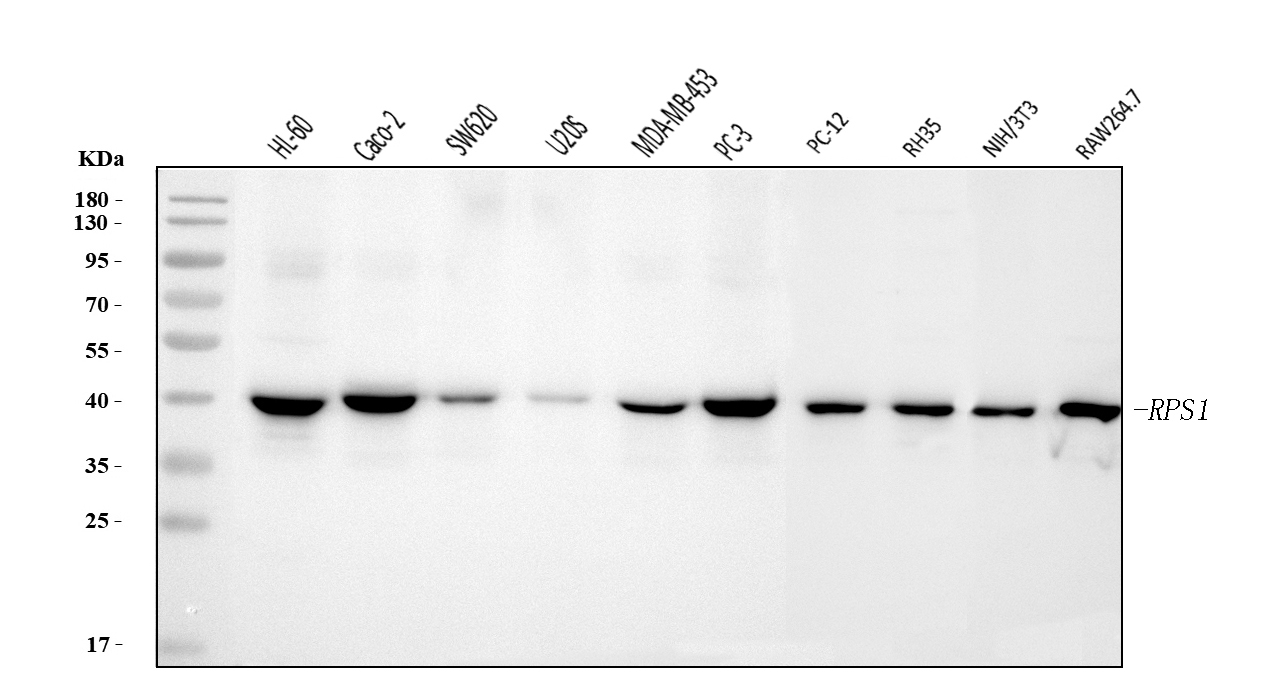
Western blot analysis of RRS1 using anti-RRS1 antibody (A04418-3). The sample well of each lane was loaded with 30 ug of sample under reducing conditions.
Lane 1: HL-60 whole cell lysates,
Lane 2: Caco-2 whole cell lysates,
Lane 3: SW620 whole cell lysates,
Lane 4: U2OS whole cell lysates,
Lane 5: MDA-MB-453 whole cell lysates,
Lane 6: PC-3 whole cell lysates,
Lane 7: PC-12 whole cell lysates,
Lane 8: RH35 whole cell lysates,
Lane 9: NIH/3T3 whole cell lysates,
Lane 10: RAW264.7 whole cell lysates.
After electrophoresis, proteins were transferred to a membrane. Then the membrane was incubated with rabbit anti-RRS1 antigen affinity purified polyclonal antibody (A04418-3) at a dilution of 1:1000 and probed with a goat anti-rabbit IgG-HRP secondary antibody (Catalog # BA1054). The signal is developed using ECL Plus Western Blotting Substrate (Catalog # AR1197). A specific band was detected for RRS1 at approximately 41 kDa. The expected band size for RRS1 is at 41 kDa.
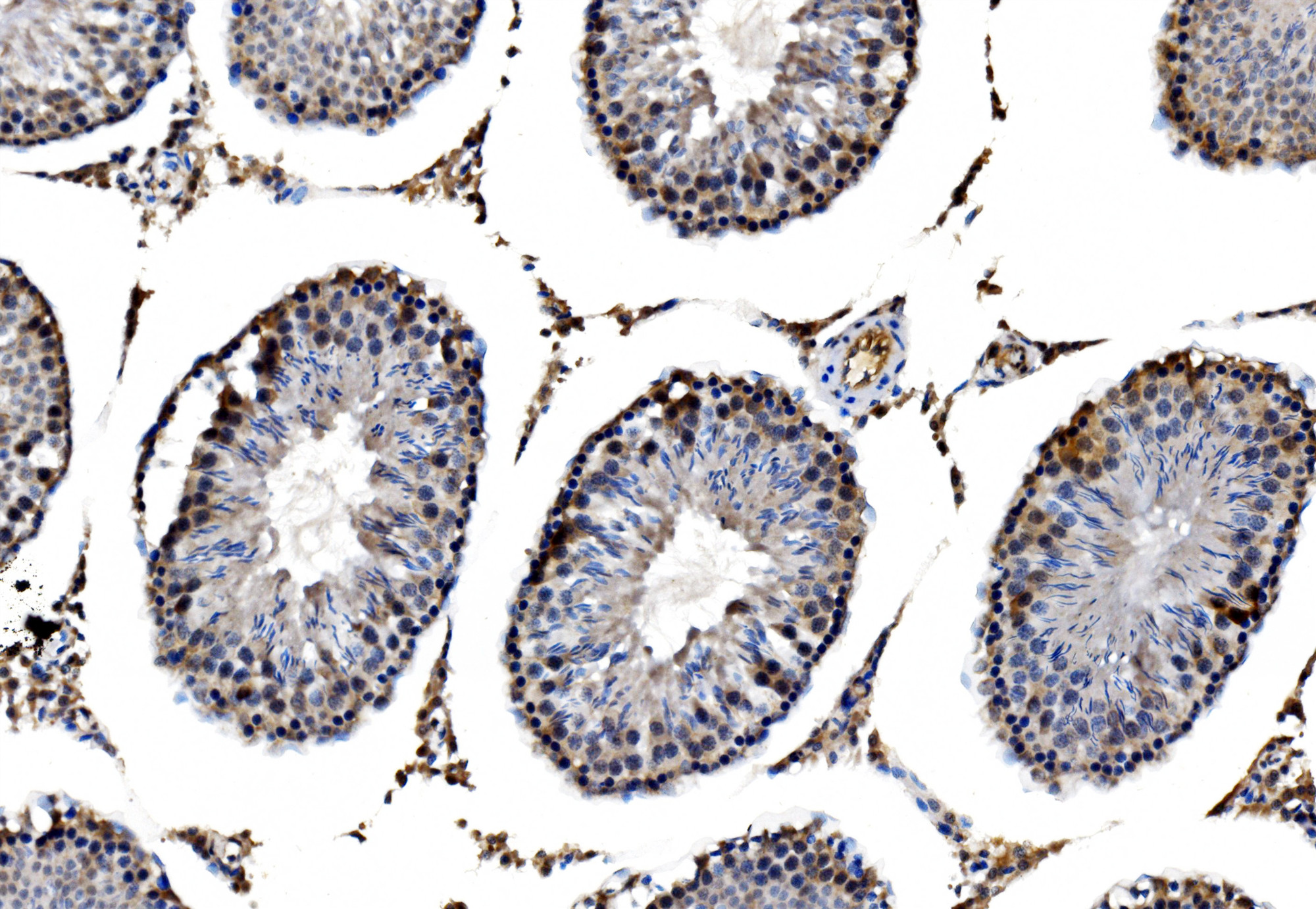
IHC analysis of RRS1 using anti-RRS1 antibody (A04418-3).
RRS1 was detected in a paraffin-embedded section of rat testis tissue. The tissue section was incubated with rabbit anti-RRS1 Antibody (A04418-3) at a dilution of 1:200 and developed using HRP Conjugated Rabbit IgG Super Vision Assay Kit (Catalog # SV0002) with DAB (Catalog # AR1027) as the chromogen.
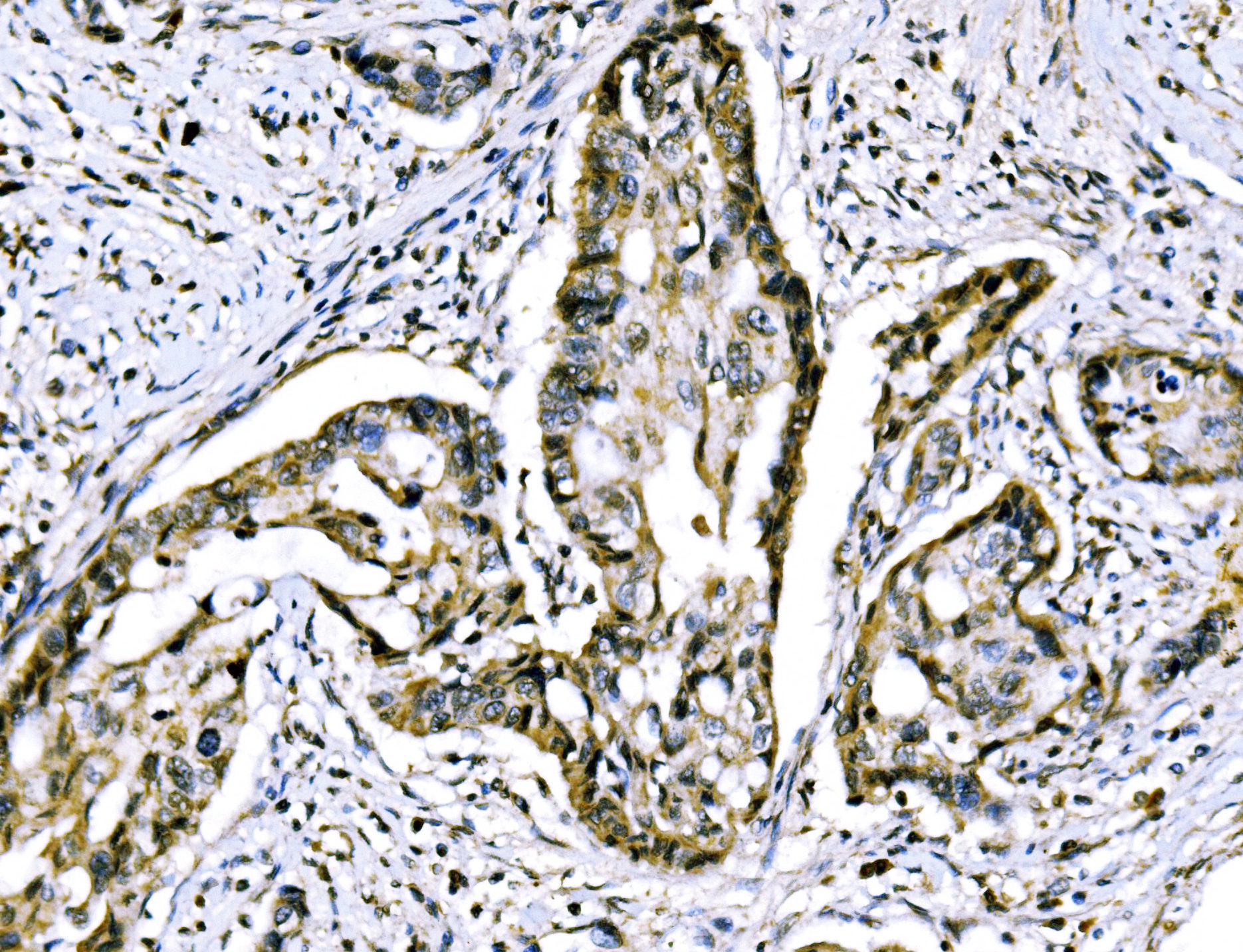
IHC analysis of RRS1 using anti-RRS1 antibody (A04418-3).
RRS1 was detected in a paraffin-embedded section of human Adenocarcinoma of the right colon tissue. The tissue section was incubated with rabbit anti-RRS1 Antibody (A04418-3) at a dilution of 1:200 and developed using HRP Conjugated Rabbit IgG Super Vision Assay Kit (Catalog # SV0002) with DAB (Catalog # AR1027) as the chromogen.
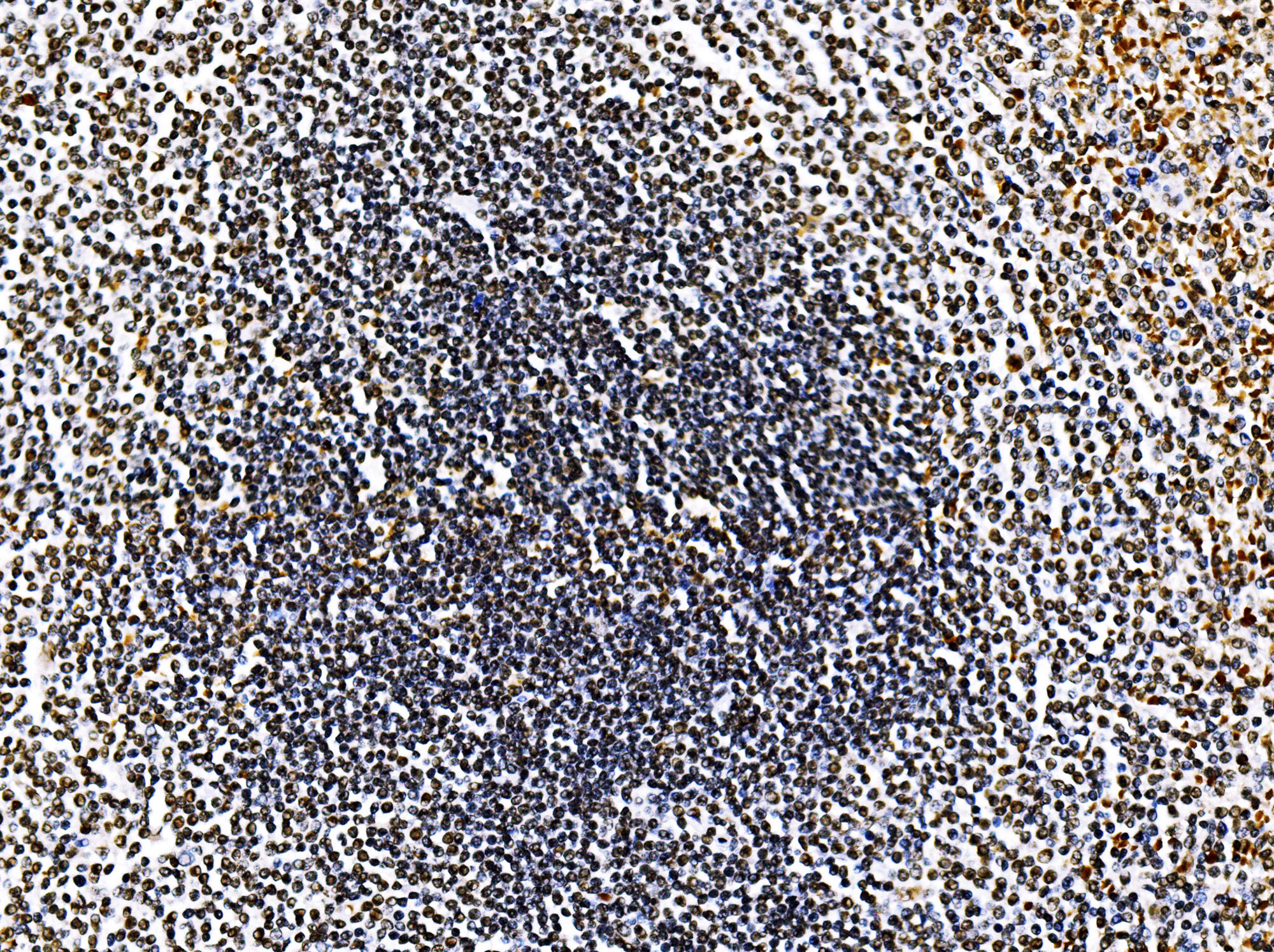
IHC analysis of RRS1 using anti-RRS1 antibody (A04418-3).
RRS1 was detected in a paraffin-embedded section of human lienal rupture tissue. The tissue section was incubated with rabbit anti-RRS1 Antibody (A04418-3) at a dilution of 1:200 and developed using HRP Conjugated Rabbit IgG Super Vision Assay Kit (Catalog # SV0002) with DAB (Catalog # AR1027) as the chromogen.
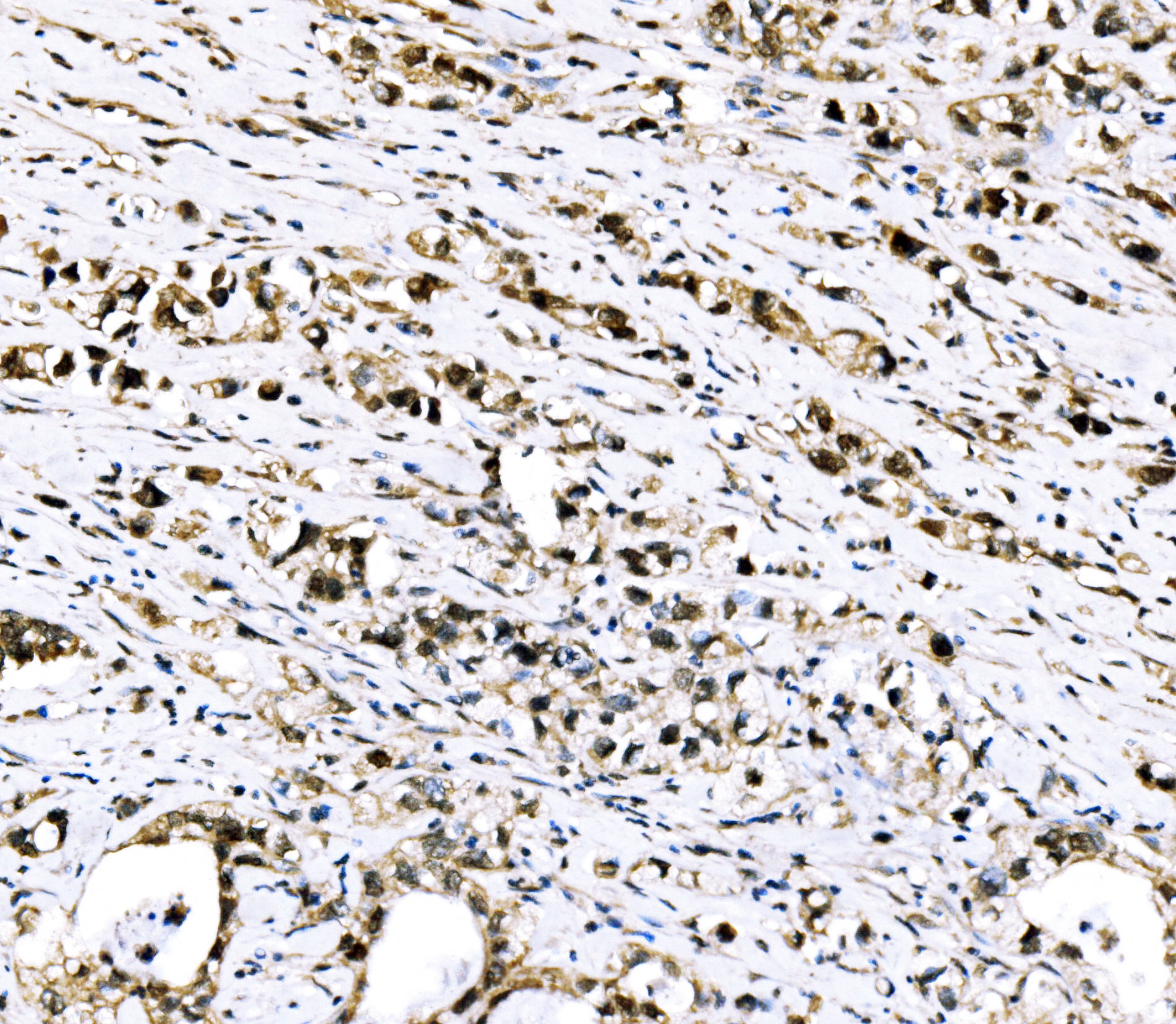
IHC analysis of RRS1 using anti-RRS1 antibody (A04418-3).
RRS1 was detected in a paraffin-embedded section of human stomach cancer tissue. The tissue section was incubated with rabbit anti-RRS1 Antibody (A04418-3) at a dilution of 1:200 and developed using HRP Conjugated Rabbit IgG Super Vision Assay Kit (Catalog # SV0002) with DAB (Catalog # AR1027) as the chromogen.
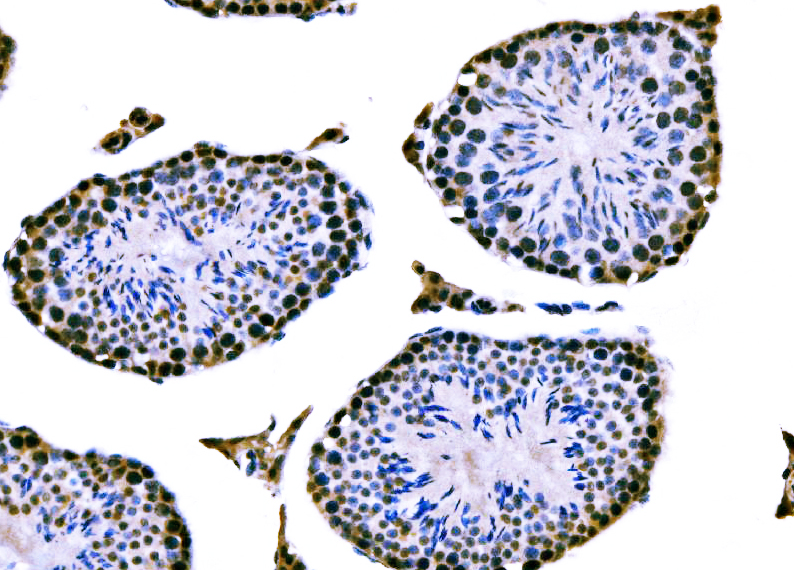
IHC analysis of RRS1 using anti-RRS1 antibody (A04418-3).
RRS1 was detected in a paraffin-embedded section of mouse testis tissue. The tissue section was incubated with rabbit anti-RRS1 Antibody (A04418-3) at a dilution of 1:200 and developed using HRP Conjugated Rabbit IgG Super Vision Assay Kit (Catalog # SV0002) with DAB (Catalog # AR1027) as the chromogen.
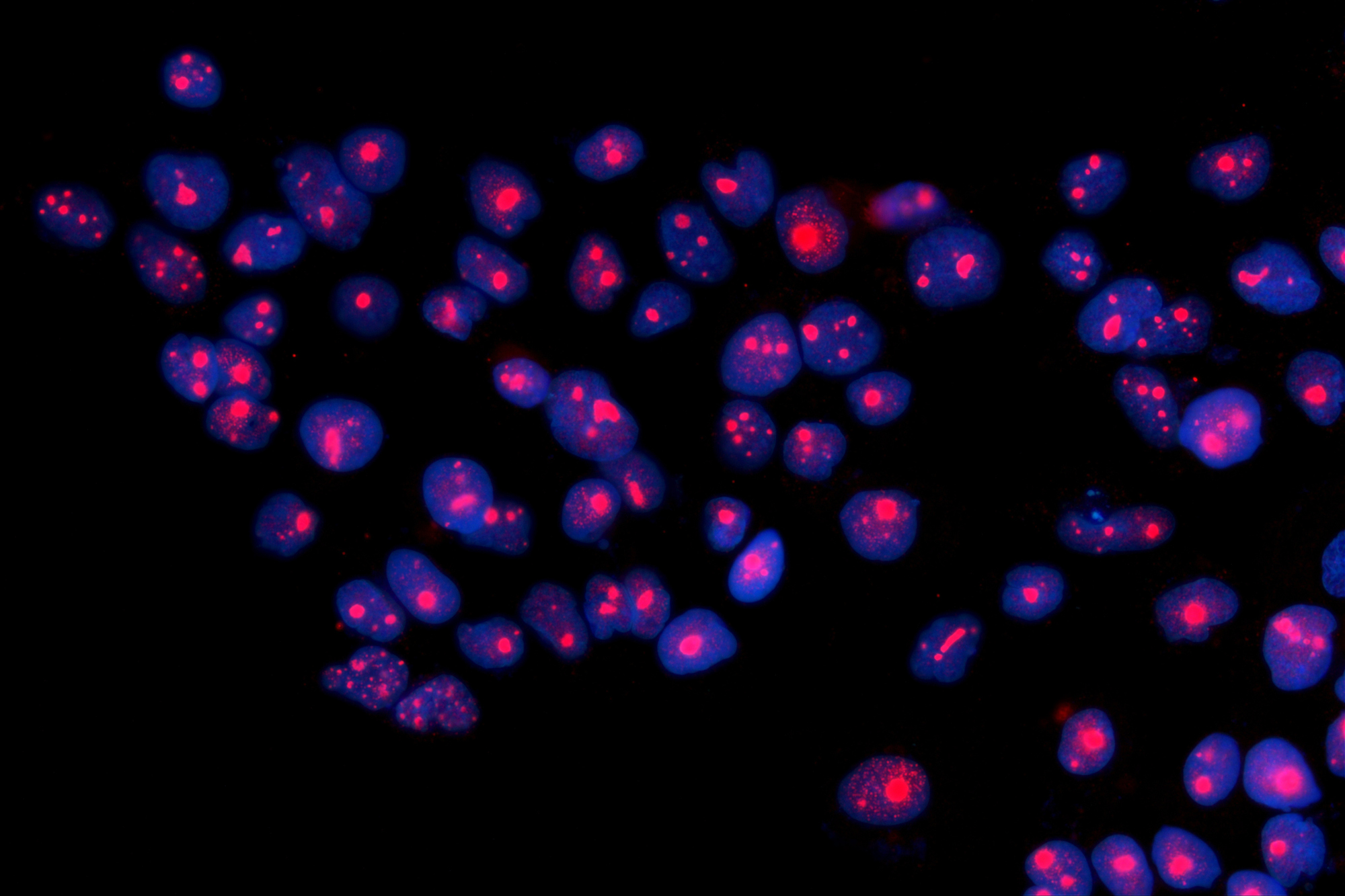
IF analysis of RRS1 using anti-RRS1 antibody (A04418-3).
RRS1 was detected in an immunocytochemical section of A431 cells. The section was incubated with rabbit anti-RRS1 Antibody (A04418-3) at a dilution of 1:100. Dylight594-conjugated Anti-rabbit IgG Secondary Antibody (red)(Catalog#BA1142) was used as secondary antibody. The section was counterstained with DAPI (Catalog # AR1176) (Blue).
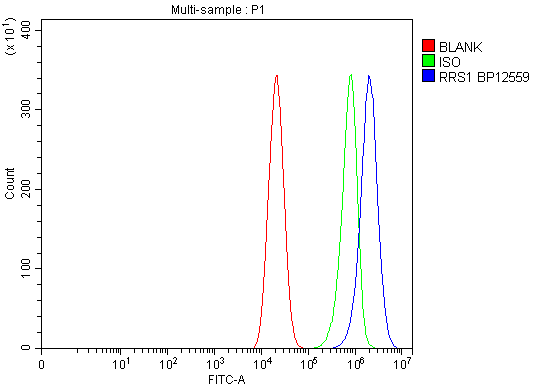
Flow Cytometry analysis of Caco-2 cells using anti-RRS1 antibody (A04418-3).
Overlay histogram showing Caco-2 cells stained with A04418-3 (Blue line). To facilitate intracellular staining, cells were fixed with 4% paraformaldehyde and permeabilized with permeabilization buffer. The cells were blocked with 10% normal goat serum. And then incubated with rabbit anti-RRS1 Antibody (A04418-3) at 1:100 dilution for 30 min at 20°C. DyLight®488 conjugated goat anti-rabbit IgG (BA1127) was used as secondary antibody at 1:100 dilution for 30 minutes at 20°C. Isotype control antibody (Green line) was rabbit IgG at 1:100 dilution used under the same conditions. Unlabelled sample without incubation with primary antibody and secondary antibody (Red line) was used as a blank control.

Western blot analysis of RRS1 using anti-RRS1 antibody (A04418-3). The sample well of each lane was loaded with 30 ug of sample under reducing conditions.
Lane 1: HL-60 whole cell lysates,
Lane 2: Caco-2 whole cell lysates,
Lane 3: SW620 whole cell lysates,
Lane 4: U2OS whole cell lysates,
Lane 5: MDA-MB-453 whole cell lysates,
Lane 6: PC-3 whole cell lysates,
Lane 7: PC-12 whole cell lysates,
Lane 8: RH35 whole cell lysates,
Lane 9: NIH/3T3 whole cell lysates,
Lane 10: RAW264.7 whole cell lysates.
After electrophoresis, proteins were transferred to a membrane. Then the membrane was incubated with rabbit anti-RRS1 antigen affinity purified polyclonal antibody (A04418-3) at a dilution of 1:1000 and probed with a goat anti-rabbit IgG-HRP secondary antibody (Catalog # BA1054). The signal is developed using ECL Plus Western Blotting Substrate (Catalog # AR1197). A specific band was detected for RRS1 at approximately 41 kDa. The expected band size for RRS1 is at 41 kDa.

IHC analysis of RRS1 using anti-RRS1 antibody (A04418-3).
RRS1 was detected in a paraffin-embedded section of rat testis tissue. The tissue section was incubated with rabbit anti-RRS1 Antibody (A04418-3) at a dilution of 1:200 and developed using HRP Conjugated Rabbit IgG Super Vision Assay Kit (Catalog # SV0002) with DAB (Catalog # AR1027) as the chromogen.

IHC analysis of RRS1 using anti-RRS1 antibody (A04418-3).
RRS1 was detected in a paraffin-embedded section of human Adenocarcinoma of the right colon tissue. The tissue section was incubated with rabbit anti-RRS1 Antibody (A04418-3) at a dilution of 1:200 and developed using HRP Conjugated Rabbit IgG Super Vision Assay Kit (Catalog # SV0002) with DAB (Catalog # AR1027) as the chromogen.

IHC analysis of RRS1 using anti-RRS1 antibody (A04418-3).
RRS1 was detected in a paraffin-embedded section of human lienal rupture tissue. The tissue section was incubated with rabbit anti-RRS1 Antibody (A04418-3) at a dilution of 1:200 and developed using HRP Conjugated Rabbit IgG Super Vision Assay Kit (Catalog # SV0002) with DAB (Catalog # AR1027) as the chromogen.

IHC analysis of RRS1 using anti-RRS1 antibody (A04418-3).
RRS1 was detected in a paraffin-embedded section of human stomach cancer tissue. The tissue section was incubated with rabbit anti-RRS1 Antibody (A04418-3) at a dilution of 1:200 and developed using HRP Conjugated Rabbit IgG Super Vision Assay Kit (Catalog # SV0002) with DAB (Catalog # AR1027) as the chromogen.

IHC analysis of RRS1 using anti-RRS1 antibody (A04418-3).
RRS1 was detected in a paraffin-embedded section of mouse testis tissue. The tissue section was incubated with rabbit anti-RRS1 Antibody (A04418-3) at a dilution of 1:200 and developed using HRP Conjugated Rabbit IgG Super Vision Assay Kit (Catalog # SV0002) with DAB (Catalog # AR1027) as the chromogen.

IF analysis of RRS1 using anti-RRS1 antibody (A04418-3).
RRS1 was detected in an immunocytochemical section of A431 cells. The section was incubated with rabbit anti-RRS1 Antibody (A04418-3) at a dilution of 1:100. Dylight594-conjugated Anti-rabbit IgG Secondary Antibody (red)(Catalog#BA1142) was used as secondary antibody. The section was counterstained with DAPI (Catalog # AR1176) (Blue).

Flow Cytometry analysis of Caco-2 cells using anti-RRS1 antibody (A04418-3).
Overlay histogram showing Caco-2 cells stained with A04418-3 (Blue line). To facilitate intracellular staining, cells were fixed with 4% paraformaldehyde and permeabilized with permeabilization buffer. The cells were blocked with 10% normal goat serum. And then incubated with rabbit anti-RRS1 Antibody (A04418-3) at 1:100 dilution for 30 min at 20°C. DyLight®488 conjugated goat anti-rabbit IgG (BA1127) was used as secondary antibody at 1:100 dilution for 30 minutes at 20°C. Isotype control antibody (Green line) was rabbit IgG at 1:100 dilution used under the same conditions. Unlabelled sample without incubation with primary antibody and secondary antibody (Red line) was used as a blank control.









